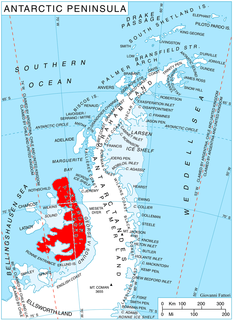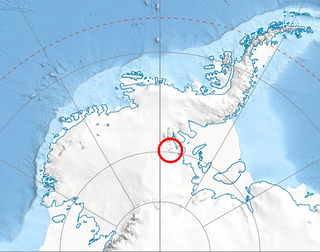The Whitmore Mountains are an isolated mountain range of the Transantarctic Mountains System, located in the Marie Byrd Land region of West Antarctica.
Brinton Nunatak is a small nunatak marking the west extremity of the Ford Nunataks, in the Wisconsin Range, Horlick Mountains. It was mapped by the United States Geological Survey from surveys and from U.S. Navy air photos, 1960–64, and named by the Advisory Committee on Antarctic Names for Curtis C. Brinton, utilitiesman with the Byrd Station winter party, 1957.
The Butler Rocks are two rock nunataks, 910 metres (3,000 ft) high, standing 2.5 nautical miles (5 km) southwest of Vanguard Nunatak in the northern Forrestal Range, Pensacola Mountains. They were mapped by the United States Geological Survey from surveys and from U.S. Navy air photos, 1956–66, and named by the Advisory Committee on Antarctic Names for William A. Butler, aerographer, Ellsworth Station winter party, 1957.
Nimbus Hills is a rugged line of hills and peaks about 14 nautical miles (26 km) long, forming the southeast part of Pioneer Heights in the Heritage Range, Ellsworth Mountains. Mapped by United States Geological Survey (USGS) from ground surveys and U.S. Navy air photos, 1961-66. Named by Advisory Committee on Antarctic Names (US-ACAN) after the National Aeronautics and Space Administration weather satellite, Nimbus, which took photographs of Antarctica from approximately 500 nautical miles (900 km) above earth on September 13, 1964.
DeGanahl Glacier is a narrow, steep-walled glacier about 10 nautical miles (20 km) long, flowing southeast from Jones Peak into the western side of Liv Glacier, opposite June Nunatak. It was discovered and photographed by Rear Admiral Byrd on the South Pole Flight in November 1929 and named for Joe deGanahl, a navigator and dog driver and a member of the Supporting Party for the Byrd Antarctic Expedition, 1928–30.
Sullivan Nunatak is a long, narrow nunatak 2 nautical miles (3.7 km) east of the south end of Wellman Cliffs in the Geologists Range. Mapped by the United States Geological Survey (USGS) from tellurometer surveys and Navy air photos, 1960-62. Named by the Advisory Committee on Antarctic Names (US-ACAN) for James G. Sullivan, United States Antarctic Research Program (USARP) geologist at McMurdo Station, winter 1961 and the 1961-62 summer season.
Penrod Nunatak is a nunatak 2 nautical miles (3.7 km) northwest of Abbey Nunatak, lying at the west side of Reedy Glacier just north of the mouth of Kansas Glacier. Mapped by United States Geological Survey (USGS) from surveys and U.S. Navy air photos, 1960-64. Named by Advisory Committee on Antarctic Names (US-ACAN) for Jack R. Penrod, builder with the Byrd Station winter party, 1957.
Espenschied Nunatak is the westernmost member of the Snow Nunataks, on the English Coast of Ellsworth Land, Antarctica. This nunatak was mapped by the United States Geological Survey from surveys and U.S. Navy air photos, 1961–66, and was named by the Advisory Committee on Antarctic Names after Peter C. Espenschied, a United States Antarctic Research Program auroral scientist at the Byrd Auroral Sub-Station, 1960–61.
Patrick Nunatak is a nunatak 3.5 nautical miles (6 km) southeast of Gambacorta Peak in southern Neptune Range, Pensacola Mountains.
Fin Nunatak is a nunatak, 805 metres (2,640 ft) high, in the middle of Casey Glacier, near the east coast of Palmer Land, Antarctica. The nunatak was photographed from the air by Sir Hubert Wilkins on December 20, 1928, and was first mapped from these photos by W.L.G. Joerg. It was surveyed by the Falkland Islands Dependencies Survey in December 1960. The name by the UK Antarctic Place-Names Committee is suggested by the fin-like shape of the feature.
The Ford Nunataks are a cluster of nunataks and low peaks rising above a network of ice-drowned ridges about 9 nautical miles (17 km) in extent, lying 7 nautical miles (13 km) northwest of Murtaugh Peak in the Wisconsin Range of the Horlick Mountains, Antarctica. They were mapped by the United States Geological Survey from surveys and U.S. Navy air photos, 1960–64, and were named by the Advisory Committee on Antarctic Names for Franklin E. Ford, a construction mechanic with the winter parties at the Byrd Station in 1961 and then the South Pole Station in 1965.
George Nunatak is a nunatak, 1,050 metres (3,440 ft) high, located midway between the eastern part of the Harold Byrd Mountains and Leverett Glacier in Antarctica. It was named by the Advisory Committee on Antarctic Names for Paul George, a member of the U.S. Army helicopter unit which supported the United States Geological Survey Topo West and Topo East surveys of 1962–63.
Gerasimou Glacier is a steep-walled tributary glacier, 5 nautical miles (9 km) long, entering the west side of Shackleton Glacier opposite the Gemini Nunataks, in the Queen Maud Mountains of Antarctica. It was named by the Texas Tech Shackleton Glacier Expedition, 1964–65, for Helen Gerasimou, a polar personnel specialist with the Office of Antarctic Programs, National Science Foundation.
The Monument Nunataks are a group of nunataks in Antarctica that have numerous pinnacles and odd-shaped projections resembling monuments, situated north of Sculpture Mountain in the upper part of Rennick Glacier. The group was named by the Northern Party of the New Zealand Geological Survey Antarctic Expedition of 1962–63.
The Morgan Nunataks are a small group of nunataks located at the southwestern extremity of the Sweeney Mountains, in Palmer Land, Antarctica. They were first observed from the air by the Ronne Antarctic Research Expedition in 1947–48, and were mapped by the United States Geological Survey from surveys and U.S. Navy air photos, 1961–67. The group was named by the Advisory Committee on Antarctic Names for William R. Morgan, a cook at Eights Station in 1965.

Lizard Nunatak is a nunatak rising to about 800 metres (2,600 ft) situated within the Nichols Snowfield, in the northern portion of Alexander Island, Antarctica. It is situated 12 km east by north of Mount Kliment Ohridski and 9 km south-southeast of the summit of Landers Peaks in Sofia University Mountains, and 6.4 km southwest of Serpent Nunatak and 9.38 km north by west of Tegra Nunatak in Rouen Mountains. The feature was so named by the UK Antarctic Place-Names Committee in 1977 from its shape and in association with Serpent Nunatak lying to the northeast.
Tyke Nunatak is the smallest and northernmost of the Bates Nunataks at the west end of Britannia Range. So named because of its small size in relation to the two southern nunataks in the group.
Rankine Rock is a rock lying 1 nautical mile (1.9 km) north of Cox Nunatak at the north extremity of Dufek Massif, Pensacola Mountains. Mapped by United States Geological Survey (USGS) from surveys and U.S. Navy air photos, 1956-66. Named by Advisory Committee on Antarctic Names (US-ACAN) for David F. Rankine, Jr., photographer with U.S. Navy Squadron VX-6 during Operation Deep Freeze 1964.
Rautio Nunatak is a nunatak rising to about 1,000 m between Neuburg Peak and Hannah Peak near the west end of Dufek Massif, Pensacola Mountains. Named by Advisory Committee on Antarctic Names (US-ACAN) after Henry Rautio, photographer, U.S. Navy Squadron VX-6, who obtained reconnaissance photographs of the Pensacola Mountains from LC-47 aircraft on January 22, 1964.





